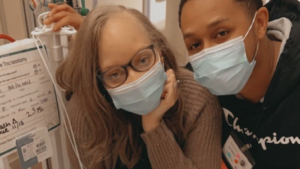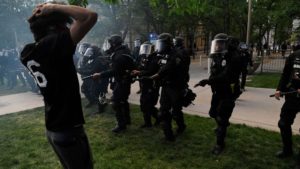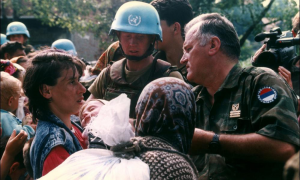MINNEAPOLIS — Minnesota’s governor activated the National Guard on Thursday as angry demonstrators took to the streets for a third straight night to protest the death of George Floyd, a black man who was pleading that he could not breathe as a white police officer pressed his knee into Mr. Floyd’s neck.
The order by Gov. Tim Walz came as the city asked for help after vandalism and fires erupted during demonstrations and as the Justice Department announced that a federal investigation into Mr. Floyd’s death was a top priority.LIVE UPDATESFollow our live coverage of protests in Minneapolis and other cities.
At a news conference on Thursday evening, U.S. Attorney Erica MacDonald pledged a “robust and meticulous investigation” into the death but stopped short of announcing criminal charges against the four officers who were at the scene, all of whom were fired after Mr. Floyd’s death was captured in a haunting videotape.
“My heart goes out to George Floyd,” said Ms. MacDonald, a former judge. “My heart goes out to his family. My heart goes out to his friends. My heart goes out to the community.”
South Minneapolis continued to seethe at the treatment of Mr. Floyd — and demonstrators railed against what they described as a city in which black lives are valued less than those of white residents.
“I want justice. I hope the continued pressure will get us charges, but we have to have some patience,” said Jamar Nelson, a community activist who works with families of crime victims. “The worst outcome is if we rush and the charges don’t stick.”
In one section of Minneapolis on Thursday night, hundreds of people held a vigil near where Mr. Floyd died, leaving new flowers and balloons not far from a mural of him, newly painted along a building’s wall.
In other parts of the city and in St. Paul, police in riot gear clashed repeatedly with protesters amid reports of vandalized buildings and fires in businesses. In Minneapolis, at least one person was injured in a stabbing during the chaos, the police said. Late Thursday, protesters climbed over fences to breach a police precinct and set it on fire as officers retreated in squad cars. Smoke poured from the precinct and nearby buildings.
Other protests — many peaceful, some convulsed by violence — were reported across the country.
Minneapolis’s deep racial divide is as much a feature of the city for its black residents as its picturesque parks, robust employment and thriving businesses.POLICE TECHNIQUEPolice departments have tried to ban or severely limit the use of chokeholds and neck restraints, which are still used in Minneapolis.
African-Americans earn one-third as much as white residents. They graduate from high school at much lower rates, are much likelier to be unemployed and tend to live in households with significantly less wealth than their white counterparts.
One university professor calls it the “Minnesota paradox” — a pleasant place belied by gaping racial inequalities.
Those disparities, the result of generations of discriminatory government policies, are now helping to fuel an uprising in the wake of Mr. Floyd’s death.


Mr. Floyd, 46, died on Monday after being handcuffed and pinned to the ground by a white police officer who pressed his knee on Mr. Floyd’s neck for about eight minutes. A video of the arrest, in which he is heard pleading “I can’t breathe,” spread widely online. A shopkeeper had called the police after he said someone had tried to use a fake $20 bill.
Outrage over the death prompted small protests on Tuesday and then a wave of larger protests on Wednesday night, with hundreds of residents spilling onto the streets, demanding police accountability and better living conditions for African-Americans. That night, some people clashed with the authorities; others broke into businesses and set them ablaze.
The demonstrations, which continued on Thursday, spread to other parts of the metropolitan area, and the State Capitol was evacuated as a precaution.GENERATIONS OF PAIN Gov. Tim Walz appeals for healing in Minnesota.
The case stirred protests in other parts of the country. Demonstrators turned out in Los Angeles on Wednesday night and in New York’s Union Square on Thursday. The protests in New York later moved to City Hall, where some demonstrators skirmished with the police. More than 30 people were arrested in those protests.
“George Floyd’s death represents every fight, every battle for black progress in this city,” said Mike Griffin, a longtime community organizer in Minneapolis.
“We want justice for George Floyd,” he continued, “but this is also about black dignity. We have had to fight tooth and nail for even the most basic standards of living. If you are white, this is a great city. If you are black, it is a struggle every day.”
Even as public officials urged calm on Thursday after a chaotic evening in which someone was fatally shot near the protests in Minneapolis, police officials from around the country condemned the police actions that led to Mr. Floyd’s death. It was a rare and remarkable public denunciation by law enforcement of their own.

Although Minneapolis is politically progressive and many white residents speak of racial justice, black residents say it has not been enough to solve the inequities. In fact, there is often resistance.
Get For You, a personalized daily digest with more stories like this.Sign up
For several years, advocates for workers pushed the city to adopt a $15 minimum wage, which the City Council did in 2017, but only after overcoming vigorous opposition from local businesses.
“A lot of white people say they are not racist because they have black friends,” Cynthia Montana said, “but they go back to their white neighborhoods with their white friends. That’s why they don’t understand and they’re surprised when this happens.”
Ms. Montana, 57, rode her bicycle on Thursday near a Target store that had been vandalized and looted during the previous night’s unrest and reflected on the challenges of growing up as a black person in Minneapolis. It begins in school, she said, where white children who get in trouble are excused as having a bad day, while black students are deemed to have disorders that need correcting.
“It’s like layer and layer and layer of gunpowder building over a long time,” she said. “And when you become an adult, it’s this stick of dynamite.”
The encounter between Mr. Floyd and Derek Chauvin, the white former officer who pinned Mr. Floyd down with his knee, in some ways represented the intersection of the different realities of black and white people in the region.


Mr. Floyd grew up in a segregated part of Houston and moved to Minneapolis several years ago. Mr. Chauvin owns two houses in predominantly white communities, one in suburban Minneapolis and another in Windemere, Fla.
“It is a metaphor for a deeply segregated and unequal city,” Myron Orfield, a civil rights professor at the University of Minnesota, wrote in an email.
Racial segregation in schools is growing faster in Minneapolis than in most places in the country, Mr. Orfield said. In 2000, there were 11 schools in the Twin Cities considered deeply segregated, with a student body that was more than 90 percent nonwhite. By 2019, that number of deeply segregated schools had increased to 170, he said.
And the intersection where Mr. Floyd died — East 38th Street and Chicago Avenue South — had an invisible barrier designed to keep out African-Americans.
Dozens of homes built as long as a century ago near that corner included deed covenants that prohibited black people from living in or purchasing those houses. Those restrictions, enshrined in housing deeds scattered across the city, deprived black residents from building wealth through homeownership. It took decades for courts to strike down those deeds, but by then, the chasm between black and white residents was deep.

Many of the neighborhoods that had covenants remain among the whitest in the city. The few enclaves where African-Americans could settle, including the area just west of where Mr. Floyd died, are fighting the forces of gentrification.
“We had this invisible system of American apartheid with these covenants,” said Kirsten Delegard, a director of Mapping Prejudice, a project to identify all the homes in the Minneapolis region with covenants. “It’s a segregation of opportunity.”
On Thursday, Mayor Jacob Frey sought to put in context the destruction that had taken place in his city, saying that it was a reflection of the black community’s anger over 400 years of inequality.
“What we’ve seen over the last two days and the emotion-ridden conflict over the last night is the result of so much built-up anger and sadness,” he said.




